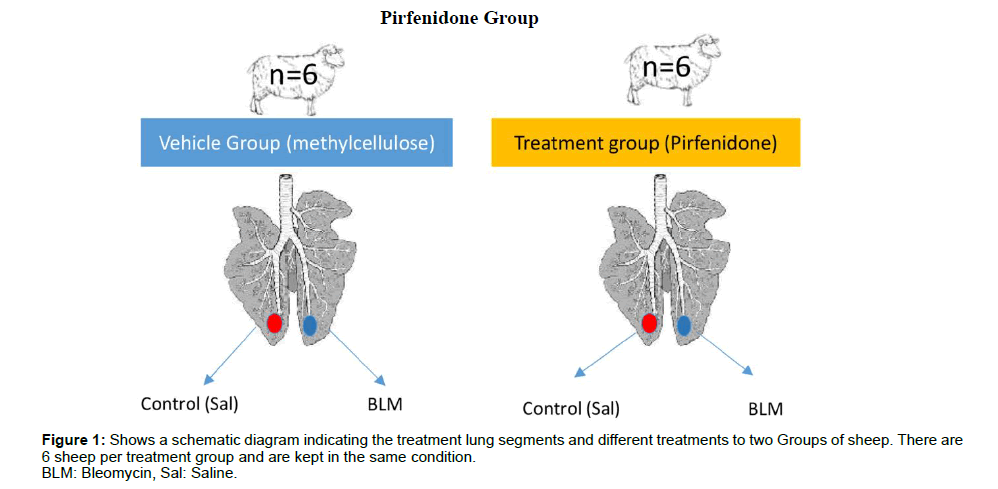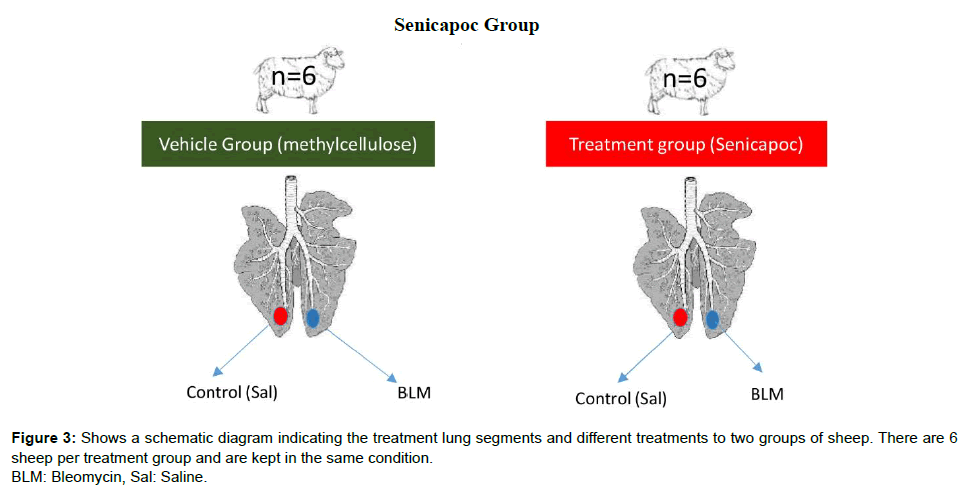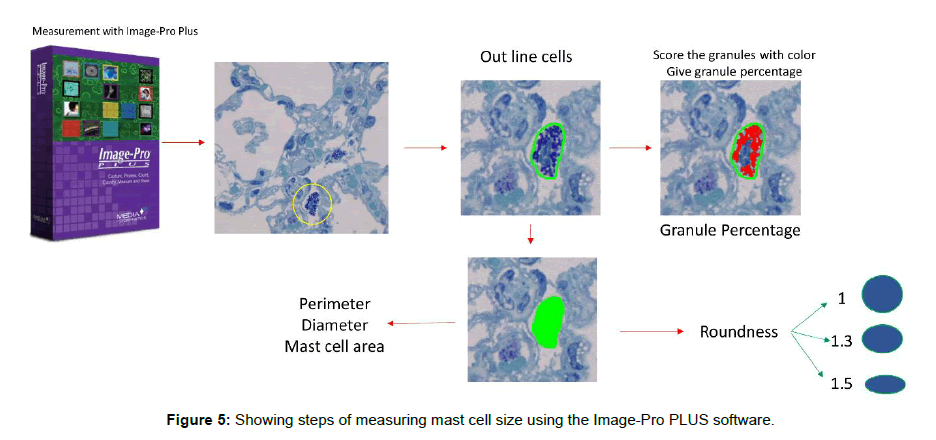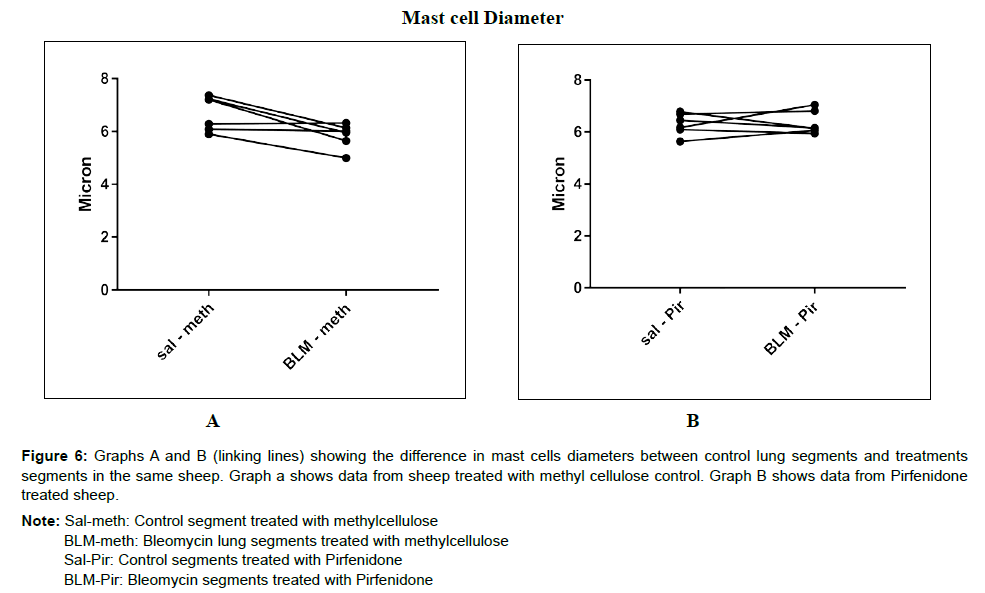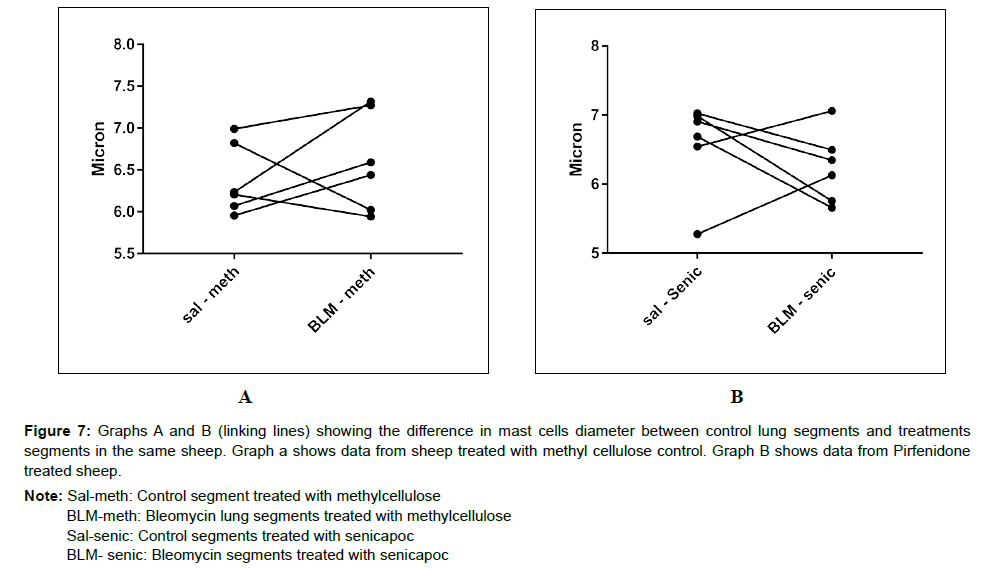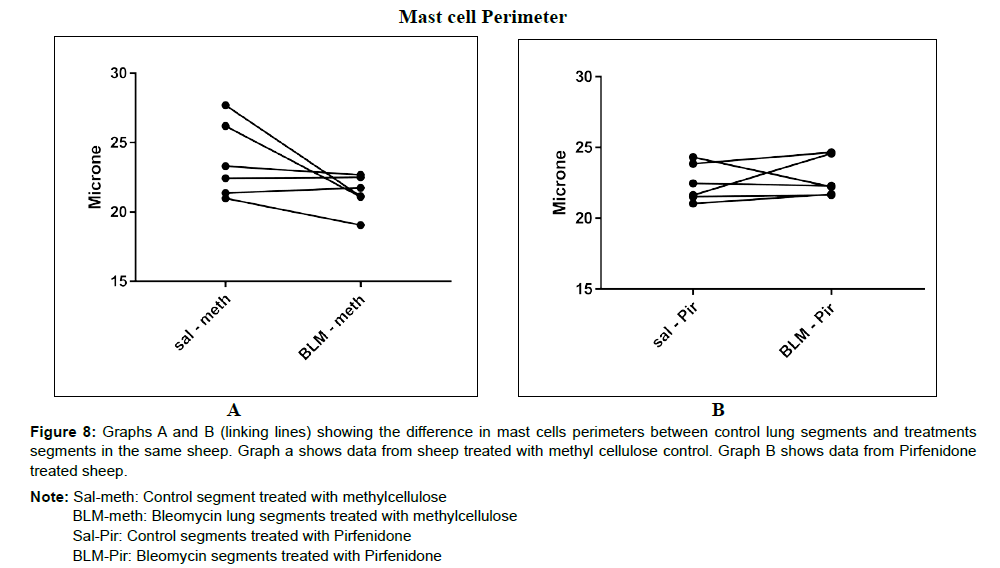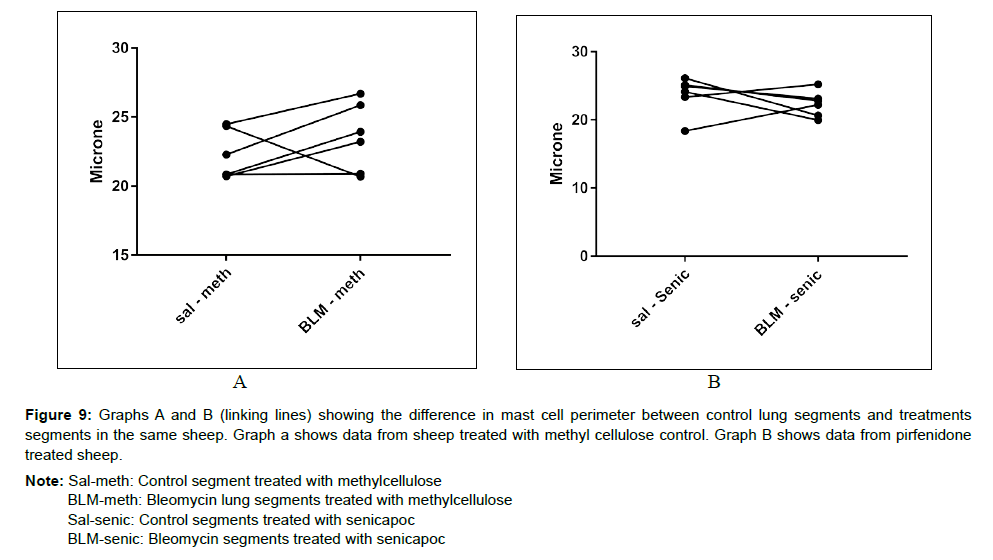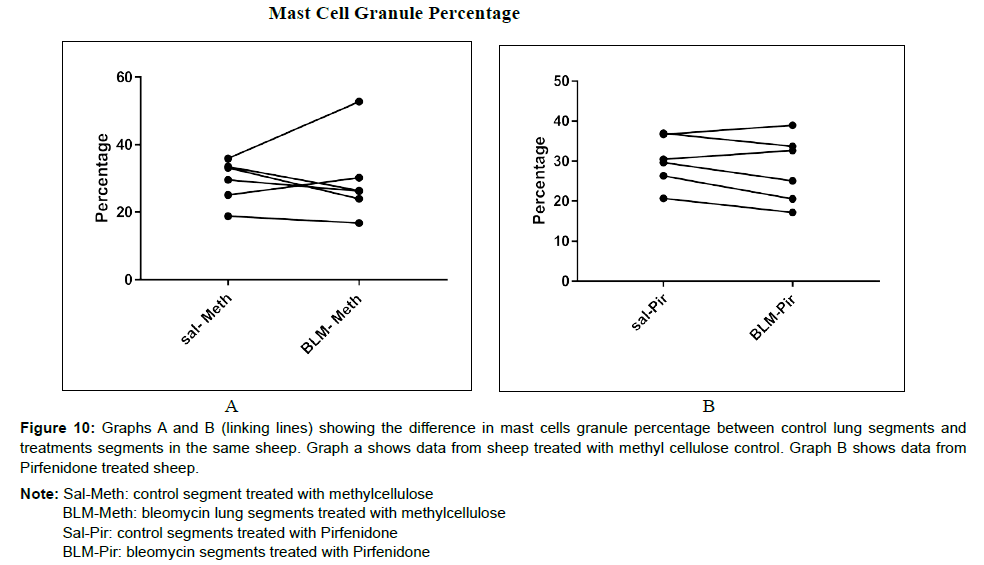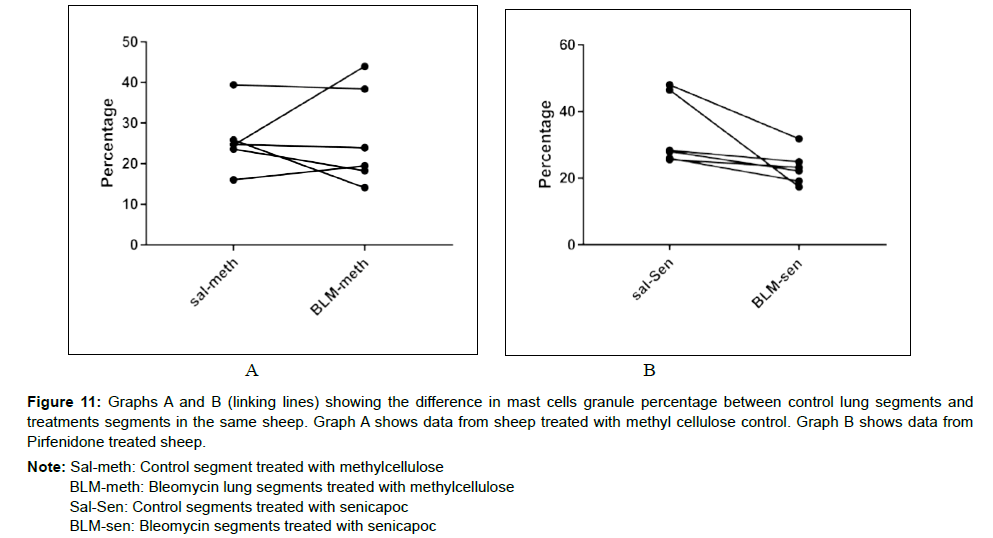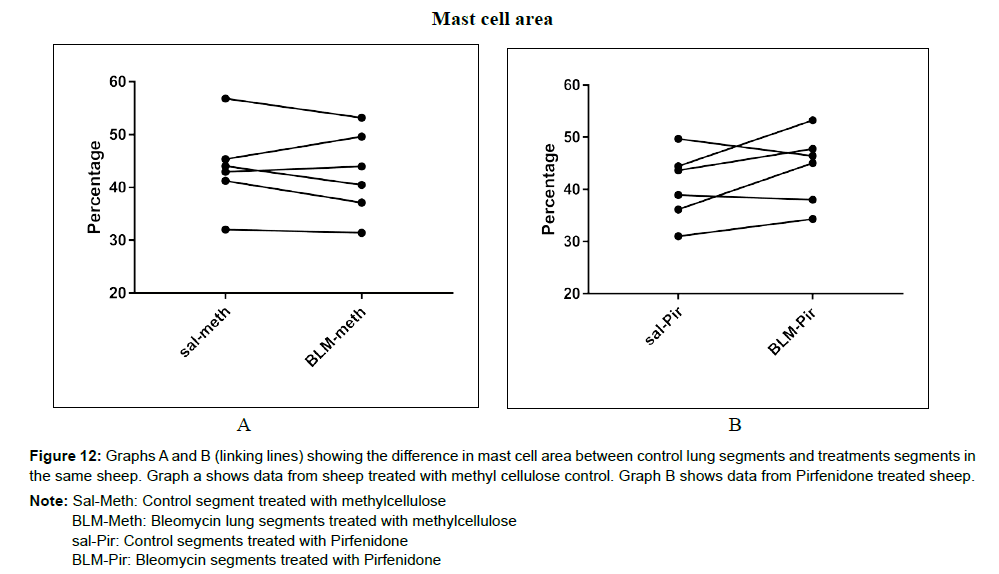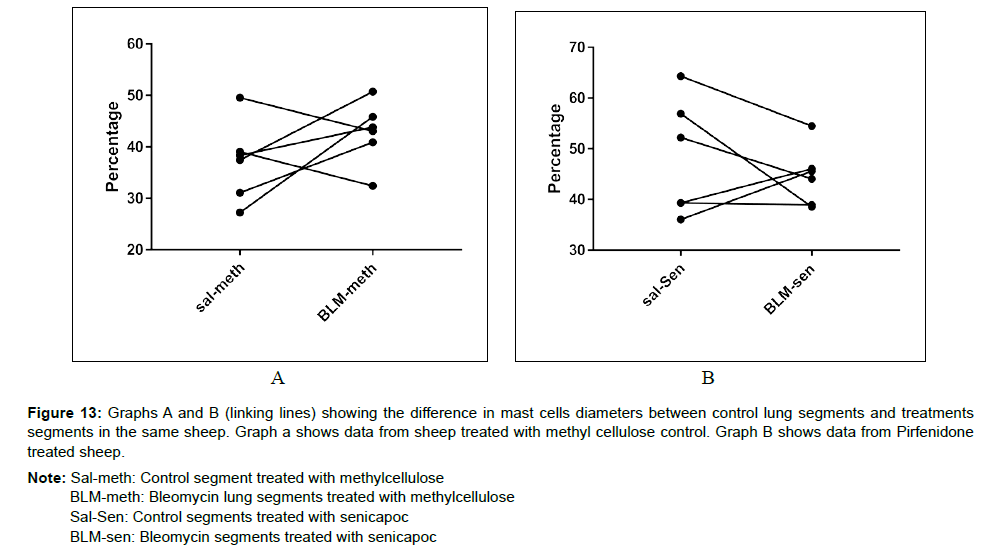Research Article, J Vet Sci Med Diagn Vol: 8 Issue: 3
Mast Cell Changes in Two Different Treatment Groups of A Sheep Model of Pulmonary Fibrosis
Bijani R*, Nimanthi VDS, Organ L and Snibson K
Faculty of Veterinary and Agricultural Science, University of Melbourne, Parkville,VIC, Australia
*Corresponding Author : Reza Bijani
Faculty of Veterinary and Agricultural Science, University of Melbourne, Parkville,VIC, Australia
Tel: +61451939904
E-mail: reza.bijani@gmail.com
Received: July 15, 2019 Accepted: August 30, 2019 Published: September 07, 2019
Citation: Bijani R, Nimanthi VDS, Organ L, Snibson K (2019) Mast Cell Changes in Two Different Treatment Groups of A Sheep Model of Pulmonary Fibrosis. J Vet Sci Med Diagn 8:3.
Abstract
Idiopathic Pulmonary fibrosis (IPF) is a progressive and devastating disease. This chronic disease is characterised by the accumulation of Extracellular Matrix (ECM) and remodeling of the lung tissue. The pathogenesis of the IPF is unclear, however, there are a certain number of known environmental and genetic risk factors that have been linked to the development of the condition such as smoking and aging.
Keywords: Mast cell; Sheep; Pulmonary fibrosis
Introduction
Different type of cells, like the epithelial-mesenchymal cell, fibroblast/myofibroblast, lymphocyte, macrophage, and mast cell contribute in the process of the disease [1-3].
IPF is a devastating disease and the survival time after diagnosing the disease is 3 to 5 years [4-7]. Diagnosis and treatment can be costly to IPF patients and the healthcare system as well. Due to a retrospective study of patients in 2008, over $1 billion dollars per year was being funded for 89000 patients and it reaches to around $2.6 billion dollars in 2013 [8,9].
IPF is defined as a “chronic fibrosing interstitial lung disease and characterized by a histopathological pattern of usual Interstitial Pneumonia (UIP)”. Deterioration of lung function and dyspnoea or shortness of breath are other symptoms of IPF. By using High- Resolution Computed Tomography, (HRCT) UIP is identified. In fact, the presence of fibrosis on peripheral portions of the lungs and subpleural accentuation are characteristic of UIP. The pleural surface displays a cobblestone appearance, which corresponds with diffuse and heterogeneous fibrosis. The histopathological characteristics of IPF are epithelial cell hyperplasia, interstitial infiltrate by plasma cells and lymphocytes and fibroblast foci. Fibroblasts foci are often found at the interface between normal parenchymal tissue and fibrotic tissue [10,11].
The focus of the present study is on mast cells and their morphologic changes in different treatment groups. In this study, we conducted measurement of the area, diameter, roundness and granule percentage of mast cells.
Materials and Methods
The lung tissues used for the research were collected from 2 Ph.D. projects that were conducted by Louise Organ and S. Nimanthi V.D., Centre for Animal Biotechnology, University of Melbourne. The study completely adhered to the Australian Code of Practice for the care and use of animals for scientific purposes.
Female merino-cross lambs aged 6 months were used in this experiment. They were sourced from one farm, transported to and housed in the Veterinary Science Animal Faculty during the experimental period. Also, all protocols outlined in this study were carried out at a room temperature of 21-22˚C. Ovine model: Recently, an ovine model for PF was developed by Organ et al., which could provide a certain number of significant improvements over the murine model. The segmental approach used allows for internal controls, with treatments not affecting adjacent lobes. It paves the way for experimental procedures such as repeat sampling of BALF via bronchoscopy, sequential lung function measurements, and repeat biopsy and blood sampling throughout the course of an experiment. Limitation treatment to defined areas, helped untreated areas of the lung remained healthy with normal function and did not result in any associated clinical effects. The ability to observe lung segments at various stages of fibrosis within the same animal is an important advantage compared to previous bleomycin models such as the mouse model. The administration of bleomycin using a bronchoscope also allows targeted exposure of the most distal areas of the lung segment to the bleomycin whilst also producing a fast fibrotic response. This simulates the fibrotic pattern seen in IPF where fibrosis begins in the most distal regions of the lung. The ovine lung is also structurally and functionally more comparable to a human lung than a mouse lung, which means physiological parameters such as lung function measurements and compliance are more similar to humans. These parameters are difficult to measure in the mouse. Sheep models are more suitable for drug delivery test. Mast cell distribution and bronchial glands in small airways with humans compared to mice. Thus the investigation of the function of these physiological features in PF is impaired in the mouse model but made possible with sheep. The sheep model of PF developed by Organ et al. manages to replicate many of the physiological changes observed in IPF and other current Bleomycin models including heterogeneous fibrosis with increased deposition of collagen and histological features similar to UIP. Organ et al. also demonstrated that lobes treated with bleomycin and significantly reduce segmental compliance with peripheral resistance and resistance in collateral channels. A more recent study of the sheep model of bleomycin-induced pulmonary fibrosis found that fibrosis was persistent up to 7 weeks post-Bleomycin treatment with reduced segmental compliance which correlated with worsening pathology scores.
Pirfenidone
Pirfenidone is an anti-fibrotic and anti-inflammatory drug, reduces deterioration in lung function in patients with idiopathic pulmonary fibrosis. Pirfenidone reduces lung fibrosis through the downregulation of the production of growth factors and procollagens I and II [12,13].
Pirfenidone inhibits the synthesis of Transforming Growth Factor (TGF)-beta, which plays a role in cell proliferation and differentiation [14].
KCa3.1 ion-channel blocker-Senicapoc
Senicapoc is a Kca3.1 ion-channel blocker and has suggested a therapeutic potential for diseases such as asthma, atherosclerosis, and kidney fibrosis. Kca3.1 are present in many cells types including activated T and B cells, macrophages, mast cells, vascular smooth muscle cells, lung epithelial cells, and fibroblasts. This means that there is also potential that Kca3.1 inhibition may have effects on the pathogenesis of IPF. It has been previously shown that pharmacological inhibition of Kca3.1 ion-channel using TRAM-34 inhibits human lung myofibroblast proliferation and wound healing in-vivo. Roach et al. also discovered that the proliferation activity of myofibroblasts is dependent on Kca3.1 ion-channel regulation of Ca2+. It has also been demonstrated that Kca3.1 ion channels are present on both murine and human macrophages. Pharmacological inhibition of the channels on human-derived macrophages in vitro, as well as in-vivo in mice has been found to reduce macrophages’ ability to produce reactive oxygen species and cytokines suggesting a reduction in M1 macrophage activation [15-17].
Bleomycin challenge: A pharmaceutical grade of bleomycin sulfate (Hospira Inc, Australia) was used to induce fibrosis in defined lobes of treated sheep. Bleomycin was made up at a concentration of 0.6 U/ml saline. (Ms. Louise Organ and Ms. S. Nimanthi V.D.). Bleomycin and saline controls were randomized between the most caudal segments of left and right lungs in each sheep (Figure 1). Sheep were restrained and bleomycin was administrated via the biopsy port of a fiber-optic bronchoscope in a 5 ml bolus (total dose 3 U/lung). 5 ml of sterile saline was administrated to the alternative lung of the sheep.
Bleomycin and saline were administrated at week-2 and repeated after two weeks at week 0, and then tissues collected on the end of week 7 (Figure 2).
Senicapoc challenge: Protocol for the dosing of the Kca3.1 ion channel inhibitor senicapoc (icagen Inc: Durham, USA) was adapted from its use in a previous study in an ovine asthma model Figures 3 and 4 [18].
Half of the sheep were orally dosed twice daily, 6 hours apart with a syringe of 30 mg/kg senicapoc in the vehicle of 0.5% Methylcel® MC (Sigma-Aldrich; Castle Hill, Australia) in distilled water. The remaining half were dosed with 40 ml of the vehicle alone. Dosing commenced daily for four weeks until culling and tissue collection at week 7.
Sheep samples
The sheep were euthanized by an intravenous overdose of barbiturate (Lethabarb, Veterinary Clinic, Werribee, Australia) at the 7 week time point for tissue collection and analysis (Animal Ethics ID: 1613909). The lungs were then removed and the target sections, which were the most caudal part of lungs, were then inflated with optimal cutting temperature compound (OCT; Sakura Finetek, USA) and several 2 mm thick slices were taken into glutaraldehyde/PBS solution to be processed for electron microscopy (EM) imaging.
Processing the specimens for TEM is done based on the protocol provided by the veterinary histology section of The University of Melbourne.
Mast cell measurements
As previous papers indicated changes in mast cells during IPF [19,20], we measured various aspects of mast cells morphology, to find probable changes and differences during various anti-fibrotic treatments.
To do this task, all images were taken by 40X with the same camera and microscope. This part of the study was done by Image-Pro PLUS, Ver. 6.3, USA. Before the start of measurements, the software was calibrated using an image of a grid with the same camera, microscope, and magnification. Then, each mast cell was outlined and granules were selected with a different color so that the software could measure the mast cell area and granule percentage. To calculate the diameter, perimeter, and roundness of mast cells, the mast cells were chosen with a different color and then the measurement conducted. For roundness, if the mast cell shape is a complete round shape, the given value is 1 however, when it changes to oval or other shapes, the value increases to a value higher than 1.
Statistics and samples/data
For the present study, a completely randomized and balanced test has been designed. The normality of data is being checked with Minitab 17 and then, a paired t-test is used to compare data collected from one animal and performing a comparison between lung segments and unpaired t-test for difference in segments of different groups. A p-value of less than 0.05 was taken as significant. Statistical analysis and graphs are performed with graph pad prism for windows. (GraphPad Software Inc. La Jolla, USA) Measurements for the size and other morphologic features of mast cells done by Image-Pro PLUS for Windows (Ver. 6.3, USA).
Results
The data in Figures 5 and 6, shows that there were no significant differences in mast cell diameters between bleomycin and salinetreated lung segments. There were also no significant differences between methylcellulose and Pirfenidone treated sheep. In graph A, p=0.282, n=6. In graph B, p=0.8144, n=6. An unpaired t-test between bleomycin segment treated with methyl cellulose versus bleomycin segments treated with senicapoc shows no significance (p=0.0829, n=6). An unpaired t-test between sal-meth versus sal-Pir also shows no significance. (p=0.2693, n=6).
Figure 6: Graphs A and B (linking lines) showing the difference in mast cells diameters between control lung segments and treatments
segments in the same sheep. Graph a shows data from sheep treated with methyl cellulose control. Graph B shows data from Pirfenidone
treated sheep.
Note: Sal-meth: Control segment treated with methylcellulose
BLM-meth: Bleomycin lung segments treated with methylcellulose
Sal-Pir: Control segments treated with Pirfenidone
BLM-Pir: Bleomycin segments treated with Pirfenidone
The data in Figure 7 shows that there were no significant differences in mast cells diameter between bleomycin and saline-treated lung segments. There were also no significant differences between methylcellulose and Pirfenidone treated sheep. In graph A, p=0.456, n=6. In graph B, p=0.3788, n=6. An unpaired t-test between BLM-meth segments versus BLM-senic segments shows no significance (p=0.2938, n=6). An unpaired t-test between sal-meth versus sal-senic also shows no significance (p=0.5629, n=6).
Figure 7: Graphs A and B (linking lines) showing the difference in mast cells diameter between control lung segments and treatments
segments in the same sheep. Graph a shows data from sheep treated with methyl cellulose control. Graph B shows data from Pirfenidone
treated sheep.
Note: Sal-meth: Control segment treated with methylcellulose
BLM-meth: Bleomycin lung segments treated with methylcellulose
Sal-senic: Control segments treated with senicapoc
BLM- senic: Bleomycin segments treated with senicapoc
The data in Figure 8 shows that there were no significant differences in mast cell perimeter between bleomycin and salinetreated lung segments. There were also no significant differences between methylcellulose and Pirfenidone treated sheep. In graph A, a paired t-test done (p=0.1094, n=6). In graph B, p=0.5952, n=6. An unpaired t-test between BLM-meth versus BLM-Pir shows no significance (p=0.0864, n=6), as well as, sal-meth versus sal-Pir. (p=0.3585, n=6).
Figure 8: Graphs A and B (linking lines) showing the difference in mast cells perimeters between control lung segments and treatments
segments in the same sheep. Graph a shows data from sheep treated with methyl cellulose control. Graph B shows data from Pirfenidone
treated sheep.
Note: Sal-meth: Control segment treated with methylcellulose
BLM-meth: Bleomycin lung segments treated with methylcellulose
Sal-Pir: Control segments treated with Pirfenidone
BLM-Pir: Bleomycin segments treated with Pirfenidone
A paired t-test between segments and an unpaired t-test between groups were performed and there was no significant difference between lung segments and treatments groups in terms of mast cell perimeter. In graph A, a paired t-test was performed (p=0.2969, n=6) (Figure 9). In graph B, p=0.3993, n=6 and there is no significance. Performing an unpaired t-test between BLM-meth versus BLM-senic shows no significance (p=0.3594, n=6), as well as, sal-meth versus salsenic (p=0.3161, n=6).
Figure 9: Graphs A and B (linking lines) showing the difference in mast cell perimeter between control lung segments and treatments
segments in the same sheep. Graph a shows data from sheep treated with methyl cellulose control. Graph B shows data from pirfenidone
treated sheep.
Note: Sal-meth: Control segment treated with methylcellulose
BLM-meth: Bleomycin lung segments treated with methylcellulose
Sal-senic: Control segments treated with senicapoc
BLM-senic: Bleomycin segments treated with senicapoc
The data in Figure 10 shows that there were no significant differences in mast cell granule percentage between bleomycin and saline-treated lung segments. There were also no significant differences between methylcellulose and Pirfenidone treated sheep (p=0.9880, n=6). A t-test was done for sal-Pir versus BLM-Pir (p=0.1958, n=6). An unpaired t-test between BLM-meth versus BLM-Pir (p=0.8214, n=6). And also an unpaired t-test between sal-meth versus sal-Pir was performed (p=0.8376, n=6) and none of them shows any significant difference.
Figure 10: Graphs A and B (linking lines) showing the difference in mast cells granule percentage between control lung segments and
treatments segments in the same sheep. Graph a shows data from sheep treated with methyl cellulose control. Graph B shows data from
Pirfenidone treated sheep.
Note: Sal-Meth: control segment treated with methylcellulose
BLM-Meth: bleomycin lung segments treated with methylcellulose
Sal-Pir: control segments treated with Pirfenidone
BLM-Pir: bleomycin segments treated with Pirfenidone
The data in Figure 11 shows that there were no significant differences in mast cell granule percentage between bleomycin and saline-treated lung segments. There were also no significant differences between methylcellulose and Pirfenidone treated sheep. A paired t-test was performed between sal-meth versus BLM-meth and no significant difference between segments of the lung in the same sheep was seen (p=0.8835, n=6). A similar t-test was done for sal-sen versus BLM-sen and there is no significance (p=0.0524, n=6). Unpaired t-test between BLM-meth versus BLM-sen shows no significant difference (p=0.5559, n=6). An unpaired t-test between sal-meth versus sal-sen does not show any significant difference (p=0.1603, n=6).
Figure 11: Graphs A and B (linking lines) showing the difference in mast cells granule percentage between control lung segments and
treatments segments in the same sheep. Graph A shows data from sheep treated with methyl cellulose control. Graph B shows data from
Pirfenidone treated sheep.
Note: Sal-meth: Control segment treated with methylcellulose
BLM-meth: Bleomycin lung segments treated with methylcellulose
Sal-Sen: Control segments treated with senicapoc
BLM-sen: Bleomycin segments treated with senicapoc
The data in Figure 12 shows that there were no significant differences in mast cell area between bleomycin and saline-treated lung segments. There were also no significant differences between methylcellulose and Pirfenidone treated sheep. In graph A, a paired t-test done (p=0.4515, n=6). In graph B, p=0.1446, n=6. An unpaired t-test between BLM-meth versus BLM-Pir shows no significance (p=0.7331, n=6), and also an unpaired t-test between, sal-meth versus sal-Pir. (p=0.4818, n=6).
Figure 12: Graphs A and B (linking lines) showing the difference in mast cell area between control lung segments and treatments segments in the same sheep. Graph a shows data from sheep treated with methyl cellulose control. Graph B shows data from Pirfenidone treated sheep.
Note: Sal-Meth: Control segment treated with methylcellulose
BLM-Meth: Bleomycin lung segments treated with methylcellulose
sal-Pir: Control segments treated with Pirfenidone
BLM-Pir: Bleomycin segments treated with Pirfenidone
The data in Figure 13 shows that there were no significant differences in mast cell area between bleomycin and saline-treated lung segments. There were also no significant differences between methylcellulose and Pirfenidone treated sheep. A paired t-test between segments and an unpaired t-test between groups were performed and there was no significant difference between lung segments and treatments groups in terms of mast cell area. In graph A, a paired t-test done (p=0.2403, n=6) and graph B, p=0.4667, n=6. An unpaired t-test between BLM-meth versus BLM-sen shows no significance (p=0.6094, n=6), as well as, sal-meth versus sal-senic (p=0.0817, n=6).
Figure 13: Graphs A and B (linking lines) showing the difference in mast cells diameters between control lung segments and treatments
segments in the same sheep. Graph a shows data from sheep treated with methyl cellulose control. Graph B shows data from Pirfenidone
treated sheep.
Note: Sal-meth: Control segment treated with methylcellulose
BLM-meth: Bleomycin lung segments treated with methylcellulose
Sal-Sen: Control segments treated with senicapoc
BLM-sen: Bleomycin segments treated with senicapoc
Discussion and Conclusion
Mast cells number increase in lung tissue in patients with pulmonary fibrosis [21-24] however, their role is still not that well understood [19,25-29]. Some studies show that they degranulate in lung tissue during the pulmonary fibrosis, others believe that mast cells influence connective tissue growth factor and they can stimulate fibrosis in lung tissues in the right environmental circumstances [30,31].
As the real role of mast cells in pulmonary fibrosis is still unclear, in the present study morphologic parameters of mast cells such as diameter, perimeter, roundness, granule percentage, and mast cell area were the focus of my study. To perform this section of the study, several images are taken from all areas of tissues slides and for more accurate results with the same magnification 40X, same microscope, and the same camera. To conduct the measurements, Image-Pro PLUS was used was calibrated with similar images of a calibrating slide (same camera, microscope, and magnification). After doing the measurements for all groups and segments, paired t-test for segments in the same sheep and unpaired t-test for segments of the lung in different sheep were performed to see whether there is a significant difference between groups.
In terms of diameter, roundness, perimeter, granule percentage and mast cell area, all segments in the Pirfenidone group were compared and despite some differences and fluctuations in measurements, there were no significant differences. For each characteristic, control segments were compared with treatment segments in the same sheep, as well as in different sheep. In other words, for this group, 4 different statistical tests were performed. Control segment versus bleomycin segment in the same sheep treated with methylcellulose as a carrier, control segments versus bleomycin lobe in the same sheep treated with Pirfenidone, bleomycin lobe treated with methyl cellulose versus bleomycin segments treated with Pirfenidone and control segment administrated with methylcellulose versus control lobe treated with Pirfenidone.
In senicapoc group, a similar test was done to investigate whether there were any significant differences between control and treatment segments in the same sheep as well as, in different sheep. Hence, diameter, roundness, perimeter, granule percentage and mast cell area measurements were compared. However, statistical tests do not present significant differences between control segment versus bleomycin segment in same sheep treated with methylcellulose as a carrier, control segment versus bleomycin lobe in the same sheep treated with Pirfenidone, bleomycin lobe treated with methyl cellulose versus bleomycin segment treated with Pirfenidone and control segment administrated with methylcellulose versus control lobe treated with Pirfenidone.
Although it was expected to see some levels of significant difference between the treatment groups, no significant differences were seen. This could be due to a number of factors listed below.
Firstly, it is possible that changes in the morphologic characteristics of mast cells occurred during the early stages of bleomycin exposure. (weeks 0-2) and then the changes returned to normal at the time samples were collected (at week 7). To investigate this hypothesis, lung samples should be collected at various times after the instillation of bleomycin and the mast cell morphology should be assessed for changes in these early stages.
Secondly, it is possible that there is no relationship between mast cells morphology and pulmonary fibrosis in the lung tissue and this requires further studies to investigate this. Lastly, the fact that we did not find any difference could be due to the insufficient number of samples. In this study, there were six sheep in each treatment group. If more samples were used, a significant difference may have been seen. To investigate this hypothesis, the morphologic characteristics should be similar in control lung segments in both drug treatments trials. Because the sheep were in similar conditions and received similar medications. Statistical tests with 12 sheep in each group were performed. In other words, control lung segments together and bleomycin administrated lobes together for both Pirfenidone and senicapoc experiments were submerged when the control sheep were administrated with methylcellulose and repeated the statistical tests for mast cell diameter, perimeter, area, granule percentage, and roundness. While there were increased sample numbers, there was still no significant difference between any of the group comparisons. This suggests that having low same numbers in samples was not the reason for a lack of significance between the groups.
References
- King TE, Pardo A, Selman M (2011) Idiopathic pulmonary fibrosis. Lancet 378: 1949-1961.
- Wolters PJ, Collard HR, Jones KD (2014) Pathogenesis of idiopathic pulmonary fibrosis. Annu Rev Pathol 9: 157-179.
- Williamson JD, Sadofsky LR, Hart SP (2015) The pathogenesis of bleomycin induced lung injury in animals and its applicability to human idiopathic pulmonary fibrosis. Exp Lung Res 41: 57-73.
- Veerappan A, Connor NJO, Brazin J, Reid AC, Jung A, et al. (2013) Mast cells: a pivotal role in pulmonary fibrosis. DNA Cell Biol 32: 206-218.
- Proud D (2008) The pulmonary epithelium in health and disease. Wiley 461.
- Herzog EL, Bucala R (2010) Fibrocytes in health and disease. Exp Hematol 38: 548-556.
- Adams TN, Eiswirth C, Newton CA, Battaile JT (2016) Pirfenidone for idiopathic pulmonary fibrosis. Am J Respir Crit Care Med 194: 374-376.
- Morell F, Esser D, Lim J, Stowasser S, Villacampa A (2016) Treatment patterns, resource use and costs of idiopathic pulmonary fibrosis in Spain-results of a delphi Panel. BMC Pulm Med 16: 7.
- Rochwerg B, Schunemann HJ, Raghu G (2016) Idiopathic pulmonary fibrosis-clinical management guided by the evidence-based GRADE approach: what arguments can be made against transparency in guideline development? BMC Med 14: 22.
- Cottin V (2014) Current approaches to the diagnosis and treatment of idiopathic pulmonary fibrosis in Europe: the AIR survey. Eur Respir Rev 23: 225-230.
- Noble PW, Homer RJ (2005) Back to the future: historical perspective on the pathogenesis of idiopathic pulmonary fibrosis. Am J Respir Cell Mol Biol 33: 113-120.
- Wang J, Yang Y, Xu J, Lin X, Wu K, et al. (2013) Pirfenidone inhibits migration, differentiation, and proliferation of human retinal pigment epithelial cells in vitro. Mol Vis 19: 2626-2635.
- Arai T, Inoue Y, Sasaki Y, Tachibana K, Nakao K, et al. (2014) Predictors of the clinical effects of pirfenidone on idiopathic pulmonary fibrosis. Respir Investig 52: 136-143.
- Selvaggio AS, Noble PW (2016) Pirfenidone initiates a new era in the treatment of idiopathic pulmonary fibrosis. Annu Rev Med 67: 487-495.
- Roach KM, Wulff H, Feghali-Bostwick C, Amrani Y, Bradding P (2014) Increased constitutive alphaSMA and Smad2/3 expression in idiopathic pulmonary fibrosis myofibroblasts is Kca3.1-dependent. Respir Res 15: 155.
- Feghali-Bostwick C, Wulff H, Amrani Y, Bradding P, Roach KM (2015) Human lung myofibroblast TGFbeta1-dependent Smad2/3 signalling is Ca(2+)-dependent and regulated by Kca3.1 K(+) channels. Fibrogenesis Tissue Repair 8: 5.
- Hansen LK, Sevelsted-Moller L, Rabjerg M, Larsen D, Hansen TP, et al. (2014) Expression of T-cell KV1.3 potassium channel correlates with pro-inflammatory cytokines and disease activity in ulcerative colitis. J Crohns Colitis 8: 1378-1391.
- Arthur GK, Duffy SM, Roach KM, Hirst RA, Shikotra A, et al. (2015) Kca3.1 K+ channel expression and function in human bronchial epithelial cells. PLoS One 10: e0145259.
- Fortoul TI, Barrios R (1990) Mast cells and idiopathic lung fibrosis. Arch Invest Med (Mex) 21: 5-10.
- Smith SJ, Levi-Schaffer F (2000) Mast cell-eosinophil-fibroblast crosstalk in allergic inflammation. Chem Immunol 78: 81-92.
- Cruse G, Bradding P (2016) Mast cells in airway diseases and interstitial lung disease. Eur J Pharmacol 778: 125-138.
- Chen KJ, Li Q, Wen CM, Duan ZX, Zhang JY, et al. (2016) Bleomycin (BLM) Induces epithelial to mesenchymal transition in cultured A549 cells via the TGF-beta/Smad signaling pathway. J Cancer 7: 1557-1564.
- Virk H, Arthur G, Bradding P (2016) Mast cells and their activation in lung disease. Transl Res 174: 60-76.
- Cha SI, Chang CS, Kim EK, Lee JW, Matthay MA, et al. (2012) Lung mast cell density defines a subpopulation of patients with idiopathic pulmonary fibrosis. Histopathology 61: 98-106.
- Krishnaswamy G, Kelley J, Johnson D, Youngberg G, Stone W, et al. (2001) The human mast cell: functions in physiology and disease. Front Biosci 6: D1109-1127.
- Kosanovic D, Dahal BK, Wygrecka M, Reiss I, Gunther A, et al. (2013) Mast cell chymase: an indispensable instrument in the pathological symphony of idiopathic pulmonary fibrosis? Histol Histopathol 28: 691-699.
- Krishnaswamy G, Ajitawi O, Chi DS (2006) The human mast cell: an overview. Methods Mol Biol 315: 13-34.
- Wang JS, Tseng HH, Lai RS, Hsu HK, Ger LP (2000) Sauropus androgynus-constrictive obliterative bronchitis/bronchiolitis--histopathological study of pneumonectomy and biopsy specimens with emphasis on the inflammatory process and disease progression. Histopathology 37: 402-410.
- Fox B, Bull TB, Guz A (1981) Mast cells in the human alveolar wall: an electronmicroscopic study. J Clin Pathol 34: 1333-1342.
- Han XJ, Chen XL, Kang L, Yun XJ, Chen C (2011) The expression of connective tissue growth factor in mast cells in the development of pulmonary fibrosis. Zhongguo Ying Yong Sheng Li Xue Za Zhi 27: 325-328.
- Tang X, He B, Li G, Zhang H, Chai L (1999) Electron microscopic studies on pathogenesis of idiopathic pulmonary fibrosis. Zhonghua Jie He He Hu Xi Za Zhi 22: 27-29.
 Spanish
Spanish  Chinese
Chinese  Russian
Russian  German
German  French
French  Japanese
Japanese  Portuguese
Portuguese  Hindi
Hindi 